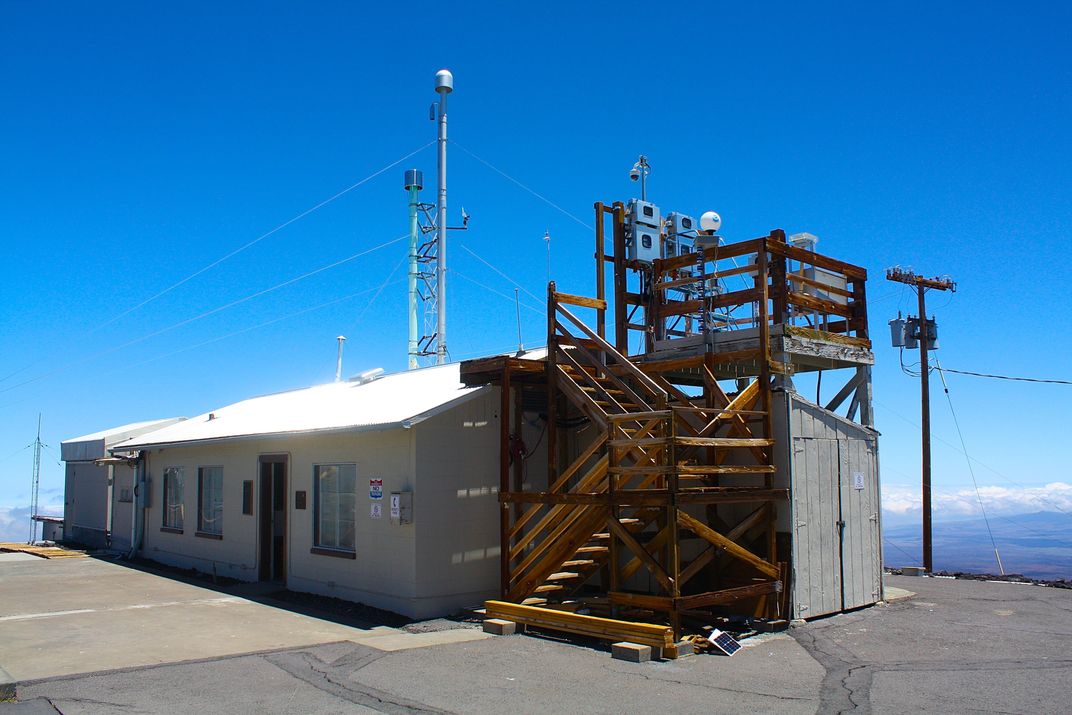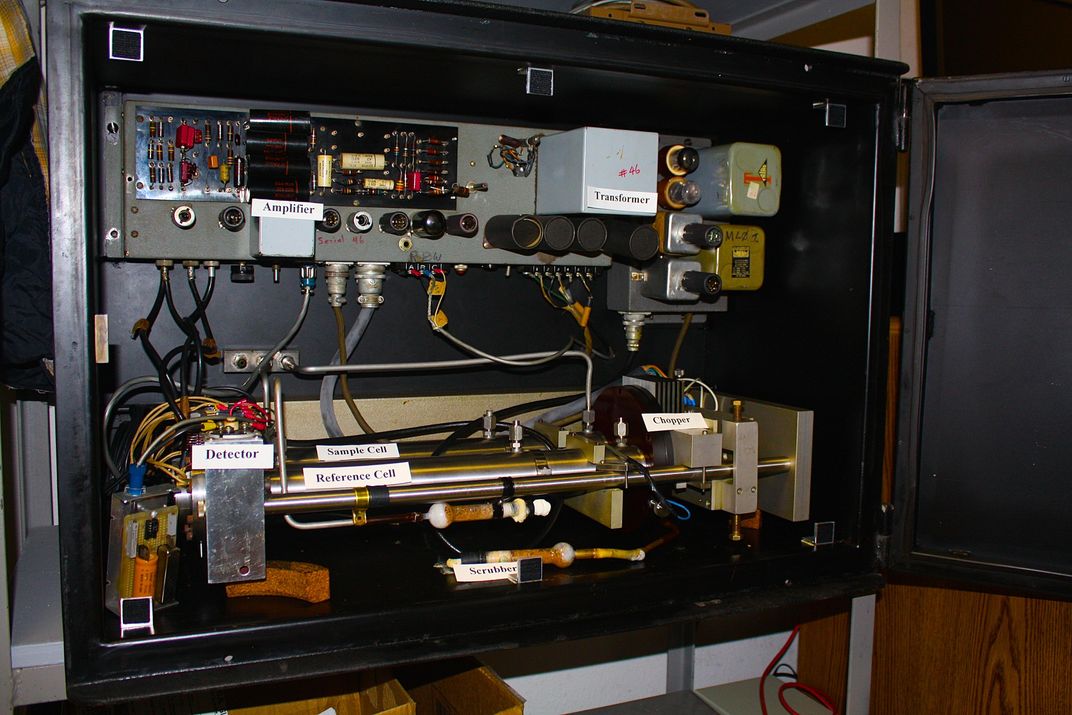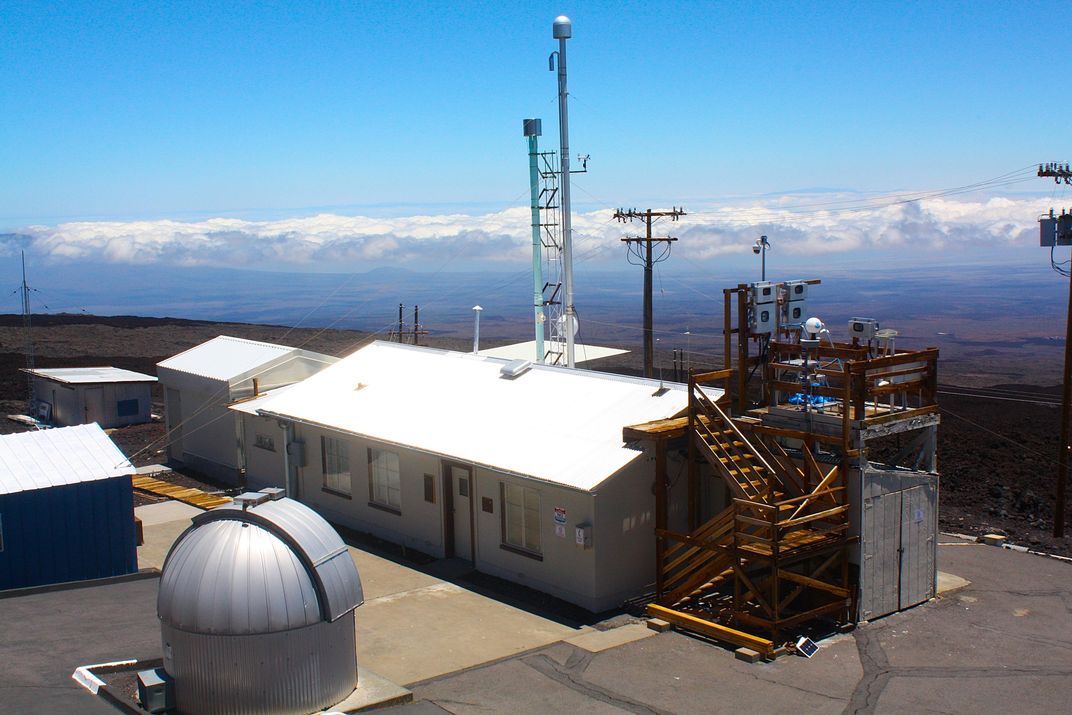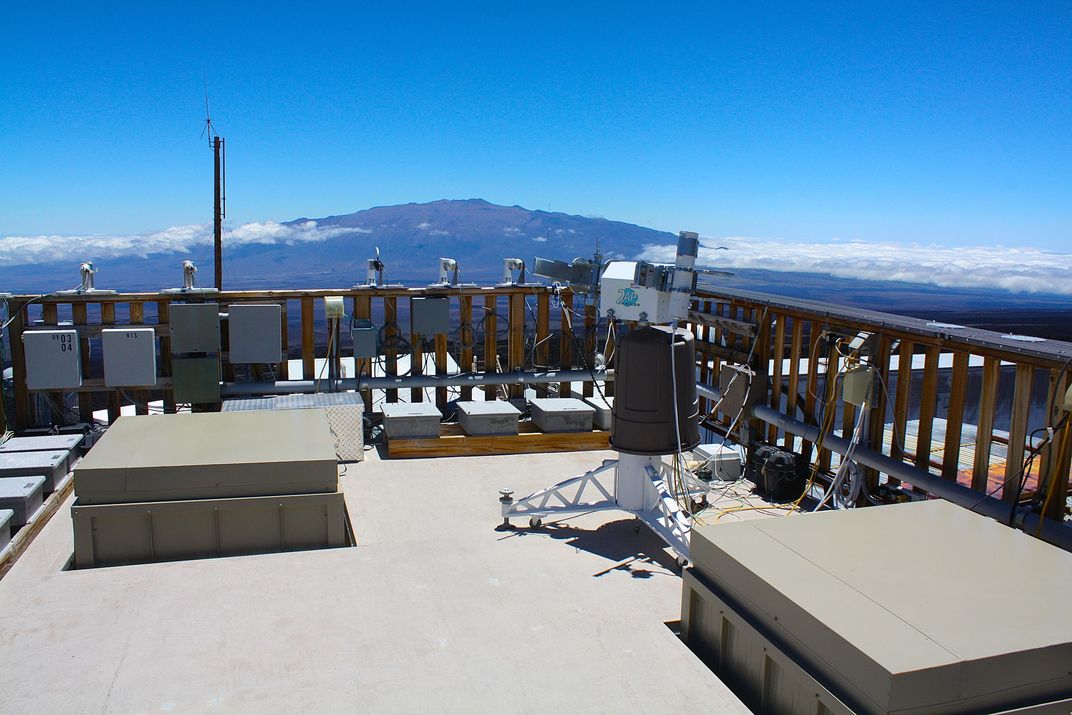The Enduring Climate Legacy of Mauna Loa
Sixty years after a trailblazing climate scientist scaled its heights, the Hawaii-based observatory remains essential
/https://tf-cmsv2-smithsonianmag-media.s3.amazonaws.com/filer/f2/e5/f2e53d07-15e9-4092-ba8f-65d93586c3ef/img_1413.jpg)
About 60 years ago, David Keeling began to wind his way up the side of Mauna Loa. At 11,135 feet above sea level, he stopped at a small, gray concrete building—the only sign of human life among miles and miles of lava rock, aside from an outhouse some 50 yards from the building. Keeling, a 30-year old scientist from California, had initially made a name for himself in the science community by devising a unique method of sampling of carbon dioxide, which had revealed some intriguing patterns—namely, that the atmospheric concentration of carbon dioxide was relatively uniform throughout the entire northern hemisphere, averaging about 310 parts per million. Now, he came to the top of the world’s largest volcano to check in on a new project that he hoped would change the way that the scientific community measured atmospheric carbon dioxide.
Keeling had ended up in Hawaii at the behest of Harry Wexler, the director of the U.S. Weather Bureau’s Division of Meteorological Research. A few years earlier, Keeling had flown to Washington, D.C. to meet with Wexler and, in the span of a few hours, had convinced the director to completely overhaul the Weather Bureau’s carbon measurement program. What the world needed, Keeling argued, was a few remote sites set up around the world, continuously measuring fluctuations in the amount of carbon dioxide that was entering, or leaving, the atmosphere.
Keeling got his wish, even if Wexler didn’t necessarily get his: Instead of joining the Weather Bureau, Keeling took a position at the Scripps Institution of Oceanography, passing over a windowless office at the Naval Observatory for the ocean breeze of San Diego. But Keeling and Wexler maintained a professional relationship, allowing both Scripps and the federal government to have a hand in the measurement program being set up in Mauna Loa—a public and private partnership that would continue for decades. In March of 1958, the first continuous measurements of carbon dioxide began at the observatory; months later, in November, Keeling visited the site for the first time.
Even just months into the program, the monitoring at Mauna Loa was already producing revolutionary results. In November, when Keeling first made the winding trek up the volcano, the measurements showed the concentration of carbon dioxide increasing—slowly, but steadily. Then, in the summer months, the opposite happened, with carbon dioxide concentrations dropping. The pattern repeated itself, almost exactly, during the second year of measurements. Keeling was fascinated.
“We were witnessing for the first time,” he wrote in his autobiography, “nature’s withdrawing CO2 from the air for plant growth during the summer and returning it each succeeding winter.” They had, in essence, captured a picture of the northern hemisphere drawing and releasing breath—exhaling carbon dioxide as forests turned bare for the winter, and inhaling as the leaves returned each summer.
The seasonal uptake and release of carbon dioxide would turn out to be just one of the stunning phenomena illustrated by the measurements at Mauna Loa. Over the next 60 years, the observatory’s data would reveal something far more sinister afoot in the atmosphere: a rapid increase of carbon dioxide in the atmosphere, caused by the burning of fossil fuels.
“If the human race survives into the twenty-first century with the vast population increase that now seems inevitable,” Keeling said during a speech presenting his research to the American Philosophical Society in 1969, “the people living then, along with their other troubles, may also face the threat of climatic change brought about by an uncontrolled increase in atmospheric CO2 from fossil fuels.”

About 400,000 years ago, an underwater volcano breached the surface of the Pacific Ocean. For the next several hundred thousand years, the volcano continued to erupt in cyclical spurts, rapidly growing until it rose some 13,680 feet above the sea. Lava flowed down the sides of the mountain, eventually hardening to form the majority of the Big Island of Hawaii. To the native Hawaiians that first populated the island, the volcano became known as Mauna Loa, or Long Mountain—indicative of its gradual slopes that encompass some 19,000 cubic miles, making it the largest volcano in the world. In 1951, a small weather observatory—dubbed the Mauna Loa Summit Observatory—opened at the summit, the result of an alliance between the U.S. Weather Bureau, the Park Service, the U.S. Navy, and prison laborers, who spent years carving out the winding road that would lead to the top of the volcano. Four years later, the Mauna Loa Observatory was built a few thousand feet down the volcano from the original summit structure; today, it remains one of the most important observatory stations in the world.
The Mauna Loa Observatory has changed little since Keeling made his first visit in 1968. A second building joined the original structure in 1997, and the facility has indoor plumbing, making the outhouse mostly obsolete, at least for visitors. Other projects now compete for research time at the observatory; over 70 projects, spearheaded by institutions around the globe, measure some 250 atmospheric constituents, from aerosols to solar radiation. But it’s still the observatory’s continuous carbon measurements—the longest running in the world—that draw the most attention. Today, the graph based on those measurements is largely known by another name: the Keeling Curve, which Thomas J. Barton, a former president of the American Chemical Society, called “an icon of modern science.”
The carbon measurements at the observatory are drawn from samples of air taken at the top of a 130-foot tower, a structure conspicuously out of place in an environment barren of anything taller than a single-story building. One hundred and thirty feet up, the air is largely free of local pollution that can sometimes be carried up the mountain by an inversion layer that forms when the sun warms the mountain, drawing air up from lower altitudes during the day and down during the night. From the tower, two lines draw air samples into a small room in the observatory’s second building. Today, both NOAA and Scripps run concurrent measuring programs at Mauna Loa, using the same air samples, but with slightly different techniques (NOAA began its monitoring program in the 70s, and has stations set up around the world, from Mauna Loa to Barrow, Alaska to the South Pole).

Keeling died in 2005, but his legacy is palpable throughout the observatory, from the dedicated plaque on the outside of the original building to the original carbon measuring device ensconced in Plexiglass in the second building’s hallway. His influence is perhaps most notable, however, in the program’s dedication to careful measurement and calibration. Hourly samples are bracketed by 15 minutes of calibration on each side, and an hour-long calibration is conducted every 25th hour. The resulting measurements are also run through a computer program that flags any outlier data—anything with too much fluctuation, or a higher-than-expected value—for manual approval. All data collected is also compared against 15 other labs around the world, and the NOAA and Scripps programs regularly examine their results against each other. Usually, the difference is so negligible as to be practically nonexistent.
“If you look at the plot of CO2 at Mauna Loa, the difference between [the Scripps] program and our program is less than the thickness of the line on the plot,” says Pieter Tans, head of the Carbon Cycle Greenhouse Gases Group in the Global Monitoring Division of NOAA's Earth System Research Laboratory. “It’s real quality assurance.”

But Keeling’s legacy of meticulous measurements isn’t the only reason that researchers at both NOAA and Scripps go to such great lengths to ensure that their results are unimpeachable. Since Keeling first presented his findings to the American Philosophical Society in 1968, the conclusion that atmospheric carbon dioxide is increasingly primarily due to the actions of mankind has become one of the most polarizing subjects in American politics. Almost a quarter of Americans believe that there is no solid evidence that the Earth has been getting warmer over the past few decades, while almost 30 percent of Americans don’t view global warming as a serious problem.
Over the same period of time, carbon dioxide has been entering into the atmosphere at an alarmingly high rate—faster than any other time in recorded history. At the same time, the planet has seen a stunning run of record-breaking temperature stretches, with 10 of the warmest years on record occurring after 1998. Recently, the measurement of atmospheric carbon dioxide at Mauna Loa passed 400 parts per million, a 42 percent increase from preindustrial levels. Making sure their numbers are undeniable is not just good science, but also protection against the threatening winds of a tempestuous political climate.
Still, for all the political strife that surrounds anthropogenic climate change, the researchers in charge of collecting the data at Mauna Loa are almost coldly apolitical. Both Tans and Ralph Keeling—David Keeling’s son, who took over the Scripps portion of the program after his father’s death—see their role not so much as influencing policy, but gathering important data.
“I got into this field not to change policy but to discover things about the Earth, and I continue to see that as my main motivation,” Ralph Keeling says. “I think the process of figuring out what society should do and how to make changes still requires people like me that are simply fact gathering.” The rest, he and Tans say, is up to the policymakers of the world.
While the younger Keeling may believe in keeping politics out of science, that doesn’t stop the science from being impacted by politics. At least half of the partnership’s funding—the NOAA part—comes from the federal government, which has made overtures several times over the past few years toward cutting funding for non-weather related NOAA research. Those political vagaries, among other things, are what make the partnership with Scripps so invaluable to the continuity of the program, Tans explains.
“It is possible that a future president or Congress decides that climate change is a hoax, and we’re going to curtail NOAA’s program,” he says. “So it’s also an assurance against such vagaries. We wouldn’t want the Mauna Loa record to be discontinued, so it’s important that not one lab, but different labs in different countries, are all doing this.”

Ensuring constant funding for the Scripps portion of the program is not without its pitfalls as well. Long-term observation studies, Keeling explains, are often the provenance of federal agencies, which often have a more predictable stream of funding for projects on an extended timeline. For private agencies, the focus is often on new discovery—not the continual monitoring of a known phenomenon.
“The challenge is that there is an expectation, as a concept of what the science enterprise is supposed to be about, that you should go one place and make a discovery and then you should go to another place and make another discovery,” Keeling says. “That was a problem my father faced, and in a way the community that is engaged in this has to keep answering. The answer is that we aren’t just studying the same thing over and over again—we are looking at the Earth in a time of extraordinary change, and it would be very irresponsible and strange to just turn off the flow of information.”
If anything, the constant monitoring of atmospheric carbon dioxide at Mauna Loa might have entered an important new phase—monitoring global efforts to curb greenhouse gas pollution. In December, nearly 200 nations met in Paris and agreed to adopt efforts aimed at keeping the world well below 2 degrees Celsius of warming—the consensus limit for when the consequences of climate change would get really, really bad. Environmentalists and climate scientists generally applauded the agreement, but there was one main point of concern: How would the world know if countries were sticking to their promises? How could we be sure that the agreement was actually working?
That’s where NOAA’s Tans thinks that the carbon measurement program can be useful—and where he sees the program going, at least in part, in the future.
“There needs to be some way of objectively verifying to what extent these policies are actually successful. We’ve been thinking for a long time about how we can do this, how we can make measurements in such a way that if a policy goal is 20 percent less emissions in 10 years, can we actually measure that from the atmosphere?” Tans says.
NOAA’s researchers have been practicing measuring known sources of methane across the U.S. to try to measure and quantify reductions in greenhouse gas emissions. Now, they are turning their attention towards carbon dioxide in cities, trying to devise a method that can capture changes in carbon emissions at a city level, and even pinpoint whether that carbon is coming from a natural source, or from the combustion of fossil fuels.
For a project that has spent more than half of the last century plotting mankind’s dangerous influence on the climate, it’s a hopeful prospect. “If the Paris agreement bears fruit and leads to reduction in emissions, we’ll start seeing that show up in the Mauna Loa record, and that will be a new discovery—we’ll see that humans are bending the curve,” Ralph Keeling says. “I’m eager to keep it going to show that there is a control knob that we can exercise.”
/https://tf-cmsv2-smithsonianmag-media.s3.amazonaws.com/accounts/headshot/natasha-geiling-240.jpg)
/https://tf-cmsv2-smithsonianmag-media.s3.amazonaws.com/accounts/headshot/natasha-geiling-240.jpg)